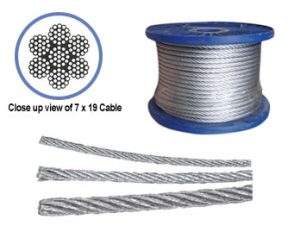
Control cables play an important role in the function of nearly all types of airplanes. They are used in flight control systems. There are primary and secondary flight control systems. Pilots can engage these flight control systems from the cockpit. Regardless, many flight control systems leverage one or more control cables.
What Are Control Cables?
Control cables are wire-based cables that are used to mechanically connect or link multiple parts. They aren’t used to transmit electricity or data. Rather, control cables are used to connect multiple parts. In airplanes, they are typically used in flight control systems.
Control cables connect controls in the cockpit to parts such as the landing gear, ailerons, elevators, rudders, flaps, trim, etc.
How Control Cables Are Constructed
While there are different types of control cables, most of them feature a similar construction. They consist of seven individual bundles of wire. In the center of a control cable is a single wire bundle, which is surrounded by six other wire bundles.
Most types of control cables are made of steel. With that said, some of them are made of carbon steel, whereas others are made of stainless steel. Carbon steel control cables are stronger, but they lack the corrosion-resistant properties of stainless steel. Regardless of the material, control cables are already strong because they are constructed of multiple bundles of wire. Therefore, many pilots prefer stainless steel control cables in their airplanes.
Understanding the Mechanics of Control Cables
Even if you’ve seen them, you might not know how control cables work. Control cables use a simple method of operation. They work by connecting control instruments — or other parts for that matter — to flight control systems.
Many control instruments are connected to flight control systems via a control cable. Moving or otherwise engaging a control instrument may pull a control cable that’s connected to a flight control system.
Control cables can wear down over time. They are exposed to physical stress, heat, and in some cases, chemicals like oil. Fortunately, they are designed to withstand these elements. But even with their durable design, control cables should be regularly inspected for signs of damage. If a control cable has any broken or frayed wire strands, it should be replaced.
In Conclusion
They may look like ordinary metal wire cables, but control cables are designed specifically for use in airplanes. They are known as “control cables” because they connect to flight control systems.



